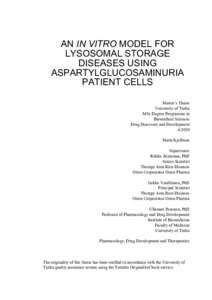An in vitro Model for Lysosomal Storage Diseases Using Aspartylglucosaminuria Patient Cells
Kjellman, Maria (2020-04-28)
An in vitro Model for Lysosomal Storage Diseases Using Aspartylglucosaminuria Patient Cells
Kjellman, Maria
(28.04.2020)
Julkaisu on tekijänoikeussäännösten alainen. Teosta voi lukea ja tulostaa henkilökohtaista käyttöä varten. Käyttö kaupallisiin tarkoituksiin on kielletty.
avoin
Julkaisun pysyvä osoite on:
https://urn.fi/URN:NBN:fi-fe2020062645985
https://urn.fi/URN:NBN:fi-fe2020062645985
Tiivistelmä
BACKGROUND Lysosomes are acidic organelles responsible for recycling of metabolic byproducts and cellular debris, and there are approximately 60 enzymes within lysosomes responsible for the recycling process. These enzymes can be malfunctional due to genetic mutations, which results in a lysosomal storage disease (LSD). One of these diseases is aspartylglucosaminuria (AGU) caused by an incorrectly folded aspartylglucosaminidase (AGA) enzyme, which results in a buildup of the substrate aspartylglucosamine. This enzymatic deficiency impairs the cellular function in both central nervous system (CNS) and periphery manifesting as an impaired physical and mental development. UNMET MEDICAL NEED Currently, there are no curative or even symptom alleviating treatments available. AIM The aim of this research was to establish a reliable in vitro model of LSD to enable repeatable experiments for drug development purposes. MATERIALS AND METHODS Two cell types from an AGU patient and an age- and gender matched healthy individual were characterized. Characterization included enzyme activity and aspartylglucosamine concentration measurements, Western Blot studies and immunofluorescent stainings. RESULTS The study showed significantly higher AGA activity in the healthy cells when compared to AGU cells, and the protein expression analysis revealed more of the precursor form of AGA in AGU cells. In line with this finding, aspartylglucosamine concentration was significantly higher in AGU cells. In addition, when AGU cells were treated with AGA, the enzyme activity could be replenished and aspartylglucosamine concentration normalized. CONCLUSION Based on these measurements, an in vitro baseline for AGU and a healthy control is now established for future studies.
